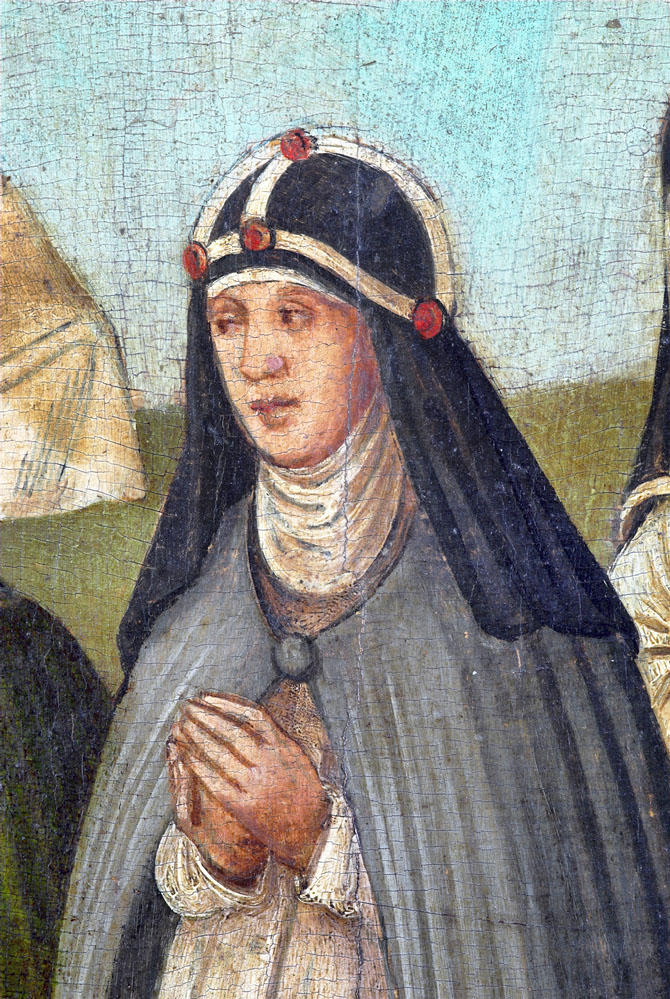|
Karin Johansdotter (d
Karin Johansdotter (died after 1605), was a Swedish Roman Catholic nun of the Bridgettine Order. She was the last nun in Sweden after the Swedish Reformation. Life Karin Johansdotter joined the Vadstena Abbey at an unknown year. She was still of childbearing age in 1605, and is thus likely to have joined the Vadstena Abbey during the reign of John III of Sweden or Sigismund III Wasa, when Sweden leaned toward a counter-reformation, and the Abbey was allowed to receive novices again: the last novice was accepted to the Abbey as late as 1593. Closure of convent In 1593, however, the Uppsala Synod proclaimed Lutheranism as state religion in Sweden, provoking a conflict between the Catholic king Sigismund and his Protestant uncle Duke Charles during the Swedish-Polish personal union, and initiating a development toward the War against Sigismund, resulting in the final completion of the Swedish Reformation. In 1594, following the Uppsala Synod, Duke Charles and Bishop Abraham Angerman ... [...More Info...] [...Related Items...] OR: [Wikipedia] [Google] [Baidu] |
Bridgettine Order
The Bridgettines, or Birgittines, formally known as the Order of the Most Holy Savior (; abbreviated OSsS), is a monastic religious order of the Catholic Church founded by Saint Birgitta or Bridget of Sweden in 1344, and approved by Pope Urban V in 1370. They follow the Rule of Saint Augustine. There are today several different branches of Bridgettines. History The first monastery of the order was founded in 1369 at the former royal castle of Vadstena. St. Bridget's granddaughter, Lady Ingegerd Knutsdotter, was Abbess of Vadstena from 1385 to 1403. Upon her death on 14 September 1412, direct descent from St. Bridget became extinct. This opened the medieval concept of "Bridget's spiritual children", members of the order founded by her, to be her true heirs. The order spread widely in Sweden and Norway, and played a remarkable part in promoting culture and literature in Scandinavia; to this is to be attributed the fact that the motherhouse at Vadstena, by Lake Vättern, was not ... [...More Info...] [...Related Items...] OR: [Wikipedia] [Google] [Baidu] |
Söderköping
Söderköping is a locality and the seat of Söderköping Municipality, Östergötland County, Sweden with 6,992 inhabitants in 2010. Söderköping is, despite its small population, for historical reasons normally still referred to as a ''town''. Statistics Sweden, however, only counts localities with more than 10,000 inhabitants as cities. Söderköping is about 15 km southeast of the city of Norrköping. History Sigismund III Vasa became king of both Sweden and the Polish–Lithuanian Commonwealth in a personal union upon his election to the Swedish throne in 1592 amidst much controversy and religious strife. The protestant reformation and Catholic counter reformation were in full swing and at odds everywhere in Europe in the day. Subsequently, in 1593, he signed an agreement to guarantee religious freedom to the Protestant majority of Sweden and to pacify the Protestant concerns overall by all sects and the religion-generated unrest in the country settled down for a ti ... [...More Info...] [...Related Items...] OR: [Wikipedia] [Google] [Baidu] |
17th-century Swedish Nuns
The 17th century lasted from January 1, 1601 ( MDCI), to December 31, 1700 ( MDCC). It falls into the early modern period of Europe and in that continent (whose impact on the world was increasing) was characterized by the Baroque cultural movement, the latter part of the Spanish Golden Age, the Dutch Golden Age, the French ''Grand Siècle'' dominated by Louis XIV, the Scientific Revolution, the world's first public company and megacorporation known as the Dutch East India Company, and according to some historians, the General Crisis. From the mid-17th century, European politics were increasingly dominated by the Kingdom of France of Louis XIV, where royal power was solidified domestically in the civil war of the Fronde. The semi-feudal territorial French nobility was weakened and subjugated to the power of an absolute monarchy through the reinvention of the Palace of Versailles from a hunting lodge to a gilded prison, in which a greatly expanded royal court could be more easily ... [...More Info...] [...Related Items...] OR: [Wikipedia] [Google] [Baidu] |


